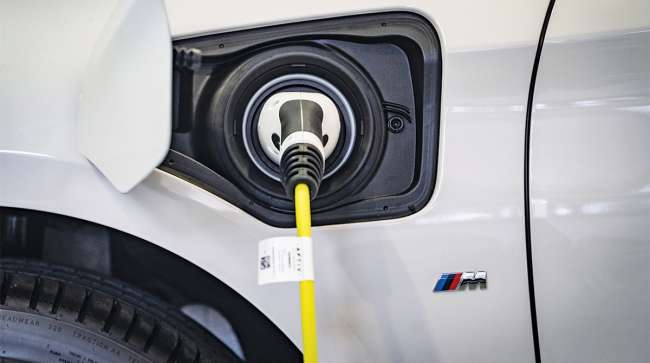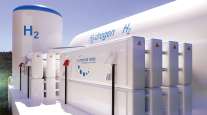The Detroit News
Obscure Energy Calculation Could Speed Up EV Future

[Stay on top of transportation news: Get TTNews in your inbox.]
WASHINGTON — Overshadowed by the Biden administration’s new tailpipe emissions rule, the Department of Energy finalized changes last month to a little-known calculation that could dramatically impact automakers’ ability to sell gas-powered cars and trucks.
The changes to the calculation, known as “petroleum equivalency factor,” will significantly cut the miles-per-gallon rating for electric vehicles, even after the Biden administration scaled back its initial proposal and added a phase-in period. After the phase-in ends in 2030, mpg ratings for EVs will be about 65% lower.
“I think very few people understand it and understand the impact and the math behind it,” said Shea Burns, an automotive regulatory expert for AlixPartners. The change is “as impactful, if not more impactful” than upcoming fuel economy regulations.
The new math, widely opposed within the industry, stretches automakers in two directions. It pushes for even more EV sales to keep pace with President Joe Biden’s climate-minded regulatory push. But it also slashes the massive fuel economy advantage for electric powertrains — a reality reflected by some automakers pivoting back to hybrids.
NEW → @Energy’s out with its little-known (but hugely significant) petroleum equivalency factor (PEF) rule.
It’s how the government determines the ‘fuel economy’ of an #EV… (1/3) — Alliance for Automotive Innovation (@autosinnovate) March 19, 2024
Currently, higher mpg ratings mean that EV sales go a long way toward satisfying automakers’ regulatory requirements for average fuel economy. By 2030, that will no longer be the case.
The Alliance for Automotive Innovation, a trade group representing all the major automakers in the U.S. except for Tesla Inc., strongly opposed the change.
“Our response is unequivocally ‘no,’ ” the Alliance wrote in a public comment on the original proposal. “The PEF should be maintained at its current level, or even increased to better reflect the petroleum savings associated with electric vehicles.”
Stellantis NV, in a public comment on the original proposal, said the rule would work against the Biden administration’s stated goal of an electrified future by “dramatically reducing EV benefit to compliance — effectively becoming a single ‘oar’ that is simply rowing backwards on a boat that is otherwise focused in a common forward direction.”
The Energy Department rule is closely related to the Department of Transportation’s Corporate Average Fuel Economy, or CAFE, standards. CAFE sets mpg targets for automakers across their product offerings.
Regardless of a company’s sales mix — between sedans, trucks, SUVs, EVs, hybrids, etc. — the average mpg across all new model-year sales must meet the federal target. If it does not, automakers face fines. Fiat Chrysler Automobiles, for example, was hit with $450 million in fines for the 2019 model year.
The Biden administration proposed new CAFE standards last June. The proposal already called for significant improvements to average fuel economy, which will now become even more difficult for automakers to achieve.
Currently, one EV sale could offset around five gas-powered car sales on company ledgers, according to Burns. By 2030, when EV fuel economy ratings will be closer to gas-powered cars, he said the ratio will be more like 1:1.
EVs are widely considered an important tool for automakers to meet new fuel economy targets and reduce emissions from the transportation sector. But as EV adoption lags, some automakers have argued that the new Energy Department rule reduces their incentive to make long-term investments in zero-emission EVs and pushes them instead toward more intermediate approaches — like hybrids, or improved internal combustion engines.
Climate Groups Push for New Math
Fully electric vehicles do not use gasoline. But they still use energy, and the electricity used to charge their batteries often comes from sources that emit pollution.
Volvo's Chayene de Souza and Magnus Gustafson discuss how new, connected trucks can boost business, enhance safety practices, and reinforce preventative maintenance plans. Tune in above or by going to RoadSigns.ttnews.com.
Congress and President Jimmy Carter, as part of efforts to conserve energy and rein in vehicle emissions, first directed the Department of Energy in 1980 to devise a calculation for “equivalent petroleum based fuel economy” of electric vehicles, the agency wrote in its finalized rule filing.
Such a calculation is helpful for regulators and consumers alike. “People don’t yet think in terms of Wh/mi (Watt hours per mile), and mpg is a familiar concept,” Burns said.
But the department had not updated its method of calculating mpg for EVs since 2000, when highly polluting coal powered more of the U.S. electrical grid and EV adoption was virtually nonexistent.
In 2021, two environmental advocacy groups — the National Resource Defense Council and the Sierra Club — petitioned the government for new, more modern regulations.
“By overstating the miles per gallon equivalent of any EVs in automakers’ fleets, the prior calculation enabled automakers to continue to sell far more gas guzzlers,” the NRDC and Sierra Club said in a joint release last month.

Burns
In their original petition, the organizations said the rules were “based on outdated data and circumstances.”
They also said the old calculation, which was meant to help the “early commercialization” of EVs, had already served its purpose. In October 2021, when the groups submitted their petition, fully electric and plug-in hybrid models represented about 5.3% of the U.S. market for new cars, according to data from Wards Auto. Now they are about 9.6%.
“There’s probably some debate about exactly what [the calculation] should be because there’s a lot of math that goes into it. But it should be significantly lower than what it is, from a pure scientific standpoint,” said Burns, adding that the old version “was inflated quite a bit to encourage EVs.”
The Environmental Protection Agency also gives its own mpg rating to electric vehicles. Those ratings, historically, have been much lower than ones assigned to EVs using the petroleum equivalency factor calculation.
The new math will bring the numbers closer together. And as part of the new rule, the Department of Energy has promised to review its calculation every year and formally propose changes as needed.
That will be important as more of the U.S. grid relies on less-polluting energy sources like solar, wind and nuclear power. With cleaner sources of electricity, the mpg ratings for EVs could rise again.
A ‘Multiplier’ of Other Rules
Burns called the new math a “multiplier” on top of the more stringent targets coming soon from the Biden administration.
That multiplier effect, he instructed, is made clear with simplified examples of how automakers would need to meet proposed CAFE targets under the old and new energy calculations.
Imagining a world where Ford Motor Co. only sold its best-selling F-150 trucks, which come in electric and gas-powered varieties, the automaker could meet Biden’s proposed 2032 fuel economy targets by reaching 25% EV sales under the old PEF math.
With the new calculation, 98% of sales would have to be for the all-electric Ford F-150 Lightning models.
Of course, automakers produce more than just trucks, which use more energy than cars and smaller SUVs. An alternative scenario helps illustrate how the rule comes into play with a more diverse product mix.
Imagine a world where Chevrolet only sold the Silverado pickup, its most popular vehicle, and the Bolt, a popular but temporarily discontinued EV. The new energy calculation would push the automaker to triple Bolt sales while selling far fewer Silverados.
Even if Biden chooses to scale back his proposed fuel economy targets — or former President Donald Trump does away with them in a potential second term — the wonkish petroleum equivalency update will make it harder for automakers to use EV sales as a powerful counterbalance to gas-powered car sales.
‘Less Well-Known but Hugely Significant’
The Biden administration originally proposed the petroleum equivalency rule on April 11 last year. The following day, the EPA released its landmark tailpipe emission proposal — which became a lightning rod for political attention and debate.
It elicited more than 4,500 public comments from private citizens, businesses and lobbyists. The Energy Department rule, by contrast, got only 49. At one point, the agency actively solicited additional feedback from major automakers.

Bozzella
Most of the public comments came from industry players who opposed the change. John Bozzella, president of the Alliance for Automotive Innovation, called the rule “less well-known but hugely significant.”
The American Automotive Policy Council, which represents the interests of Ford, General Motors Co. and Stellantis, warned last year that the new rule would cause steep fines on the Detroit Three and undermine their investments into EVs. The council urged the government to hold off on finalizing the rule before other regulations were finalized.
The only automakers to support the rule as initially proposed were Tesla and Rivian Automotive Inc., which make only all-electric vehicles.
Industry opponents did win two important concessions from the Biden administration in the final rule. Most importantly, the new calculation will phase in between 2027 and 2030, rather than going into effect all at once in 2027, as originally proposed.
The Alliance had argued there was not enough lead time for the industry to adjust to a sudden implementation.
The Biden administration also softened — by about 25% — how much it was downgrading EV fuel economy. The original proposal pegged the PEF at 23,160 watt-hours/gal, whereas the final will land at 28,996 Wh/gal in 2030
Want more news? Listen to today's daily briefing above or go here for more info
Bozzella said the phase-in compromise was “positive” and commended the Biden administration for better harmonizing the rule with the EPA’s tailpipe emissions rule and proposed CAFE standards.
“My sense is that agency coordination is starting to happen across the government,” he wrote in a blog post. But he still called into question why fuel economy standards should even exist for fully electric vehicles. “I’m not sure there’s a need for CAFE in an electric vehicle world,” Bozzella said.
Even with those compromises, environmental groups cheered the new rule.
“The automakers’ free ride is over,” said Pete Huffman, a senior attorney at NRDC. “This important update from the Department of Energy will curtail automakers’ use of phantom credits they used to keep selling gas guzzlers. They now need to hit the accelerator on more fuel-efficient vehicles, saving consumers money at the pump.”
Distributed by Tribune Content Agency, LLC





